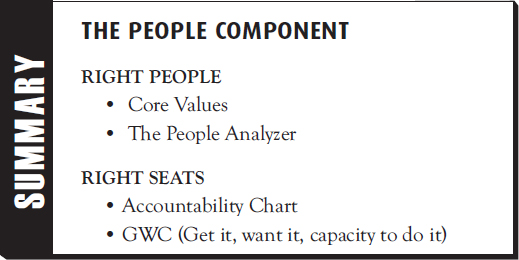SURROUND YOURSELF WITH GOOD PEOPLE
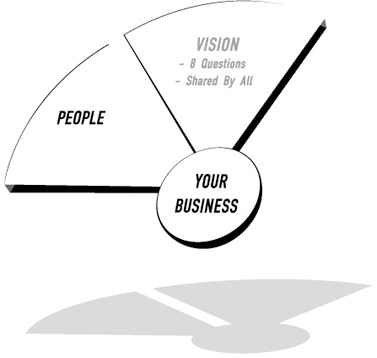
Have you ever noticed that great leaders frequently credit their success to having “good people”? What the heck does that even mean? Whenever I asked these leaders what exactly that meant, I seemed to get a different answer every time. Eventually, I realized that the answers were all exactly the same. Sure, the words were different, but the context never changed. In this chapter, I’ll cut through all the confusing terminology such as “good people,” “A players,” “platinum,” “top quartile,” and “superstars,” and get to the root of the matter.
It all comes down to getting the right people in the right seats. Jim Collins made this idea very popular in his bestseller Good to Great. It’s an idea that has been around for a long time. Unfortunately, there has never been a crystal clear definition for what it actually means. As a result, it was another term among a complex mix of terminologies that only added to the confusion. And yet the definition is actually quite simple.
The right people are the ones who share your company’s core values. They fit and thrive in your culture. They are people you enjoy being around and who make your organization a better place to be. A perfect example is the receptionist for Autumn Associates. As she returned home from vacation, her flight was delayed for so long that her plane landed only an hour before she was due back to work for an 8:00 a.m. meeting. The employees had created a custom of wearing logo apparel to all company meetings, so she had her mother pick her up from the airport with her company shirt. She changed in the car and was at work on time, apparel and all. This exemplified two of the company’s core values—commitment and caring. In this chapter you will be introduced to your second EOS tool, the People Analyzer, which will cut through the murkiness of personnel choices to show you who’s right for your company.
Core Values + People Analyzer = Right People
The right seat means that each of your employees is operating within his or her area of greatest skill and passion inside your organization and that the roles and responsibilities expected of each employee fit with his or her Unique Ability®.1 This is a concept created by Dan Sullivan and is a registered trademark of The Strategic Coach, Inc. In the book Unique Ability, authors Catherine Nomura, Julia Waller, and Shannon Waller explain that everyone has a Unique Ability®. The trick is to discover yours. When you’re operating from within your Unique Ability®, your superior skill is often noticed by others who value it. You experience never-ending improvement, feel energized rather than drained, and, most of all, you have a passion for what you’re doing that presses you to go further than others would in this area. When this combination of passion and talent finds the right audience, it naturally creates value for others, who, in return, offer you greater rewards and more opportunities for further improvement. It’s like your personal core focus. When a person is operating in his or her Unique Ability®, he or she is in the right seat.
One of the obstacles in gaining traction and achieving your vision is that roles, responsibilities, expectations, and job descriptions are unclear due to structural issues. A hazy structure may have gotten you to where you are, but it will not take you any further. A common mistake entails creating a structure to accommodate people you like or don’t want to lose. When creating a structure to function efficiently, you must take the long view. Sometimes this means eliminating or changing seats that are no longer relevant. To break through the ceiling, you must make sure you have the right structure in place to get you to the next level. That leads us to the Accountability Chart, the ultimate tool for structuring your organization the right way, defining roles and responsibilities, and clearly identifying all of the seats in the organization.
Unique Ability® + Accountability Chart = Right Seats
As you move forward, you’ll be faced with two types of issues regarding your people. The first is having the right person in the wrong seat. The second is having the wrong person in the right seat. In order to gain traction, you’ll need to address both. Let’s look at them one at a time.
RIGHT PERSON, WRONG SEAT
In this case, you have the right person (i.e., one who shares your core values), but he or she is truly not operating in his or her Unique Ability®. This person has been promoted to a seat that is too big, has outgrown a seat that is too small, or has been put in a position that does not utilize his or her Unique Ability®. Generally, this person is where he or she is because he or she has been around a long time, you like him or her, and he or she is a great addition to the team. Until now, you probably believed you were helping this person by promoting him or her to his or her existing seat. In actuality, you were hindering his or her growth and the growth of the company. Your job in this situation is to move this person out of that seat and into a seat that is right for this person, one where he or she will be successful.
Assuming that there is such a seat—and most of the time, there is—the problem is solved once you move this person. Unfortunately, sometimes there is no seat available. In this case, you have to make a very difficult choice. You have to make decisions for the greater good of the business, and you don’t have the luxury of keeping people around simply because you like them. If this is the case, you must let them go. This will be one of the toughest issues you will have to face. Once the change is made, the company is always better off, and usually the person is happier in the long run.
WRONG PERSON, RIGHT SEAT
In this case, the person excels at what he or she does, is extremely productive, and is clearly in his or her Unique Ability®. What makes this person the wrong person is that he or she doesn’t share your core values. While this obstacle may seem like something you can live with in the short term, that person is killing your organization in the long run. He or she is chipping away at what you’re trying to build, in little ways that, most of the time, you don’t even see. It’s that wry comment in the hallway, the dirty look behind your back, and the dissension that this person spreads.
Early in the process, one client had a wrong person, right seat issue. The company’s top salesperson was a man without integrity. While he was very friendly, professional in his approach, and knowledgeable, he constantly shaded the truth to make sure he had the successful quote. His new business growth was 20 percent per year, and his clients never complained. Because the leadership team had not identified their core values yet, they let the situation drag on for 12 months. As they realized how he was building the business, they faced a seemingly difficult decision. Only after letting him go did their employees and vendors open up about their feelings and concerns. He was damaging the company’s reputation the entire time he worked for it. Their core values were now in writing, and they included integrity. “Never again will we allow an employee to work for us without living this core value,” the owner stated.
No matter how difficult the issue is, you have to make a good business decision here for the long haul. If you have a wrong person in the right seat, ultimately that person must go for the sake of the greater good.
Of course, there is a third type of people issue, and that is wrong person, wrong seat. The solution is obvious: That person must go. But the way you reached that point isn’t always obvious. Another client had a CFO for more than 20 years. In the beginning, he shared the core values, was talented, and was absolutely in the right seat. As time went on, the business, industry, and technology changed, and he didn’t change with them. The seat was outgrowing him. His attitude also changed considerably. He became resentful, aloof, and less friendly than he used to be. He was no longer the right person or in the right seat. The owners had not noticed the change until the core values and the right structure were clarified and put in place. They wrestled with the thorny issue for a year and a half, all the while giving their CFO chances to change with the times and adopt the new core values, to no avail. Left with no other choice, they replaced him with a new CFO. The difference was like night and day. Their sessions were considerably more productive, the finance department finally got reorganized, and the company positioned itself to make the next leap ahead.
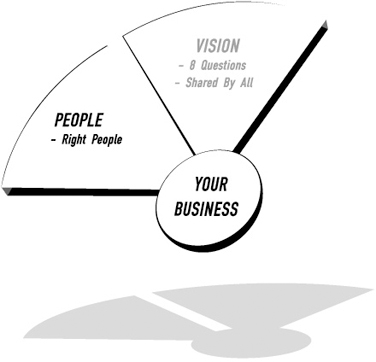
Your job is to hire, fire, review, reward, and recognize all of your people around core values and Unique Abilities®. That’s the way to build an organization with all of the right people in the right seats.
Let’s see how this can be done in practical terms. The following tools will enable you to assess your people and make the right choices. We’ll turn first to Right People and then to Right Seats.
With the answer to the first question on the V/TO—“What are your core values?”—you now have the ability to define who the right people are for your organization. It’s important to note that whatever your core values are, they don’t make the people who don’t possess them right or wrong, nor do they make them good or bad. They just don’t fit in your company culture. If they go somewhere that has their values, they’ll be fine and they’ll probably thrive. Keeping in mind your core values, it’s now time to turn to the tool that will show you what you have.
THE PEOPLE ANALYZER
I often observed my clients discussing people issues in terms that were very subjective and unproductive. They often never really resolved their people issues, and when they did, the process took twice as long as it should have. Out of necessity, I created a tool to make such discussions much more tangible.
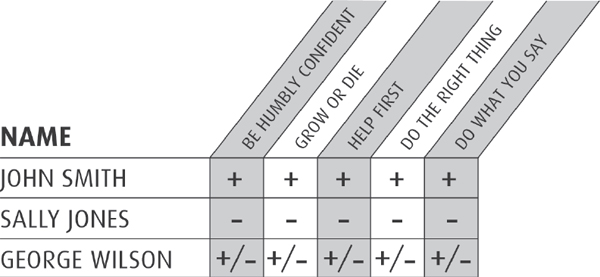
The People Analyzer is designed to clarify whether you have the right person in place or not. This is one of the top five tools used by all my clients. The concept was actually created by my dad back in the early 1970s for evaluating salespeople, and I have altered it into a tool that helps evaluate an individual’s core values. The People Analyzer template can be downloaded from www.eosworldwide.com/people.
First, put the names of the people you’re going to analyze in the left column. Then list your core values across the top. Then rate each person according to his or her adherence to the core values. Give one of three ratings:
+ He or she exhibits that core value most of the time.
+/− Sometimes he or she exhibits the core value and sometimes he or she doesn’t.
− He or she doesn’t exhibit the core value most of the time.
You will notice in the preceding example, John is absolutely the right person for your organization, George is very much on the fence, and Sally must go.
The ideal you’re shooting for in your organization is to surround yourself with 100 percent of the right people, who look just like John does. However, this is only an ideal, so don’t get caught up in perfection. What your leadership team has to do is determine what the bar is. The “bar” is the minimum standard you will accept from the People Analyzer results. The power of setting the bar is that you give all managers absolute clarity on what is acceptable and what is not. Once managers know your expectations, they will hold their people accountable accordingly.
The recommended bar for a company with five core values is three pluses, two plus/minuses, and never a minus. This is strictly my recommendation based on past experience. I have clients with higher and lower bars, so you must decide for yourself. The key point is that anyone who is at or above the bar is the right person, and your goal is to get 100 percent of the right people in your organization.
THE THREE-STRIKE RULE
What do you do if someone is below the bar? Before you make any drastic decisions, I highly recommend that you first communicate the People Analyzer results to the person and give that person the chance to better his or her performance. He or she will improve almost all of the time. The question is, will he or she improve enough to move above the bar? Most people will, some won’t, but you should give them a chance to perform according to the new structure.
The three-strike rule works as follows:
Strike One: Discuss the issues and your expectations with the person, and give him or her 30 days to correct the problem.
Strike Two: If you don’t see improvement, discuss his or her performance again and give him or her another 30 days.
Strike Three: If you still don’t see improvement, he or she is not going to change and must go. When the termination finally happens, all of those who are the right people will thank you for it and wonder what took you so long.
In practice, you will discover that you don’t have to fire people most of the time. Once you create an awareness of your core values through your initial speech, quarterly state-of-the-company meetings, the People Analyzer, performance reviews, and the three-strike rule, the people that don’t fit won’t last until the third strike. Some don’t even last until the first. Instead, they’ll leave on their own, because they know they don’t fit.
What this process does is smoke them out. Consider the following example: One leadership team had a member that was definitely not a fit. He was the VP of sales and marketing. In our first two sessions, I watched him sweat through creating their Accountability Chart and squirm through the process of discovering their core values. It was becoming very clear why the company’s sales had stagnated for a few years. By the third session, he begged off, saying he had an important client meeting out of town and could not attend. By the fourth session, he had quit the company and taken another position. He was then replaced with someone who was the right person in the right seat. As a result, the client experienced growth for the first time in three years. This is a perfect example of how someone can muddle through in an organization that lacks clarity over roles, values, and expectations. When these tools are in place, with increased focus and accountability, there is simply no place for them to hide.
I recommend the four following steps to use with the People Analyzer:
STEP 1
After discovering your core values as a leadership team, “people-analyze” each other, as all EOS clients do. This will accomplish two objectives. First, it will validate your core values. If you’re all weak in one particular value, you should question whether or not it truly should be included. Second, you will see if someone on the leadership team is below the bar. While this tough situation does not come up often, you must follow the three-strike rule with this person as well. Most of the time, this person will improve his or her performance. Sometimes he or she will opt out.
STEP 2
Have your leadership team people-analyze everyone in the organization and then have each manager share those results in one-on-one sessions. This will bring the tool to life throughout the organization.
STEP 3
Use the People Analyzer in your quarterly performance reviews with all team members. Let them analyze you as well. Don’t be afraid to put your money where your mouth is.
STEP 4
If your leadership team is struggling with a personnel problem, run the person through the People Analyzer. This will give you a clear perspective on whether it’s a right-person issue. If it is, there is nothing more to discuss and you now know how to solve it. If it isn’t, and it might be the person’s seat, don’t worry—we’ll cover that next.
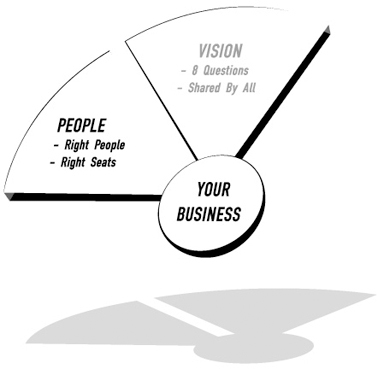
Once you’re confident you have selected the right people, it’s important to get them in the right seats. That means all of your people are operating in their Unique Abilities® and those abilities are clearly in line with their roles and responsibilities.
A seat cannot be created until the organization is structured in the right way so as to lift your company to the next level. To create that structure, we’ll use a powerful tool called an Accountability Chart. This is a supercharged organizational chart, and, when completed, it will help owners and leadership team members clearly grasp their own roles and responsibilities. That will, in turn, enable them to do the same for their people.
THE ACCOUNTABILITY CHART
This tool does not assume there is only one way to structure an organization. You could read a hundred books on organizational development and find a hundred different opinions on the way to structure an organization. The key question is this: What is the right structure to move your organization forward in the next six to 12 months?
Next to the V/TO, the Accountability Chart has the most impact of any EOS tool. It forces its users to view their organization in a different way and to address people issues that have been holding them back for years.
For this exercise to have impact on your company, you’ll need to instill a few ground rules:
1. You must look forward. You cannot look back or get caught up in the present. It will distort your judgment.
2. You must detach yourself from the existing business, your current role, and your ego.
3. You must elevate yourself above the business, look down on it, and make decisions for the long-term greater good of the company.
The Accountability Chart starts with a fundamental belief that there are only three major functions in any business and those three functions make every organization run, regardless of whether it’s a start-up business or the largest company in the world.
To illustrate the three major functions, picture three boxes side by side by side. In the box to the left, you have the first major function: sales and marketing. In the middle box is the second: operations. In the box to the right, you have the third: finance and administration. You may call them by different names, but those are the three major functions. Sales and marketing generate business. Operations provides the service or manufactures the product, and takes care of the customer. Finance and administration manage the monies flowing in and out as well as the infrastructure.
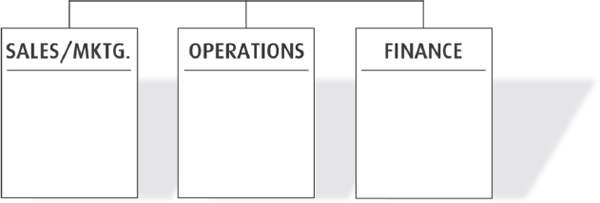
Assuming that three major functions exist in all organizations, the next truth is that they must all be strong.
I’ve had many debates about whether sales and marketing is the most important function. The argument is always that until somebody sells something, nothing else happens. That’s hard to disagree with. But realistically, all three have to be strong.
To make the point, let’s consider three scenarios:
• You have a strong sales and marketing function, a ]weak operations function, and a strong financial function. What’s the net effect? In that scenario, you’re doing a great job selling and bringing in new customers, but you’re losing them right out the back because operations is not delivering what you promised and customers aren’t happy.
• You have a strong sales and marketing function, a strong operations function, and a weak financial function. What’s the net effect? Again, you’ll bring in a lot of customers and take good care of them, but money is coming in the front door and going right out the back due to a lack of financial controls: $10 million in and $10 million out, or worse, $10 million in and $10.2 million out. This may strike a nerve because many companies fall into a situation where there is no monitoring of spending, nor is individual customer profitability assessed.
• You have a weak sales and marketing function, a strong operations function, and a strong financial function. What’s the net effect? A bunch of talented people in operations and finance are waiting around for something to happen, and nothing is.
If any of the three major functions are weak, your organization is not as effective. Given that they are all equally important, it’s time to apply the Accountability Chart. In order to maintain accountability, only one person can ultimately be in charge of any major function within an organization. Only one person oversees sales and marketing, only one person runs operations, and only one person manages finance and administration. When more than one person is accountable, nobody is.
When leadership teams do this exercise for the first time, they often discover they have two or even three names in a box. This may happen with you as well. If it does, you’ve uncovered a root issue for your company’s lack of growth or chaos, and you must solve it by reducing the number of names to one. The all-for-one and one-for-all approach won’t build a solid company. It may have gotten you here, but only clear accountability will boost you to the next level.
To take structure a step further, these three functions cannot operate independently of each other. That’s why all great organizations have another major function, a role that I like to call the integrator.
INTEGRATORS
The integrator is the person who harmoniously integrates the major functions of the business. When those major functions are strong and you have strong people accountable for each, great healthy friction and tension will occur between them. The integrator blends that friction into greater energy for the company as a whole.
I use the term “integrator” to cut through all the wonderful titles for this role, such as CEO, president, general manager, king, or queen. It doesn’t matter what you call it, but the bottom line is that the integrator is the person who has the Unique Ability® to run the organization, manage day-to-day issues that arise, and integrate the three major functions. The integrator is the glue that holds the company together.
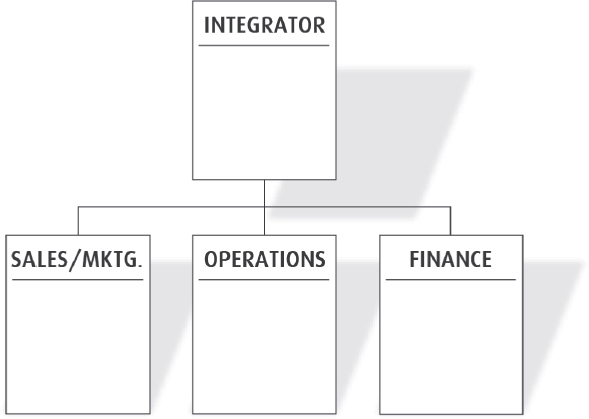
That is the basic structure of the Accountability Chart. With that understanding, two other very important factors need to be taken into account when creating the right structure for your organization.
First of all, when customizing the Accountability Chart for your company, the three major functions might split into more functions. For example, sales and marketing sometimes splits into a distinct sales function and a distinct marketing function. Operations sometimes splits into two or three distinct functions such as delivery, project management, or customer service. Finance and administration can split into as many as four: finance, administration, information technology (IT), and human resources (HR).
Depending on the size and state of your organization, you will end up with anywhere between three and ten major functions on that front line. As long as you stay focused on what the right structure is for your organization, the right number will come. Please remember, though, less is more. Not one EOS client has more than seven major functions.
The second factor is another major function that is not on the front line. In my experience, when a company creates its Accountability Chart, half the time they realize that besides an integrator integrating the major functions, there’s another very powerful role in the organization. This role shows up above the integrator function, and it’s called the visionary.
VISIONARIES
The concept of the visionary within an Accountability Chart is one of my greatest discoveries. I’ve had clients teach this concept at universities to MBAs on my behalf. Understanding and implementing this concept is eye-opening and empowering. Frankly, it has also kept some partners from killing each other.
The visionary and the integrator couldn’t be more different. In a small to mid-size company, the visionary is typically the owner, co-owner, or founder. In a partnership, most of the time, one partner is the visionary and the other is the integrator. It’s a dynamic that has elevated them to where they are. The visionary typically has 10 new ideas a week. Nine of them might not be so great, but one usually is, and it’s that one idea each week that keeps the organization growing. For this reason, visionaries are invaluable. They’re typically very creative. They’re great solvers of big ugly problems (not the little practical ones), and fantastic with important clients, vendors, suppliers, and banking relationships. The culture of the organization is very important to them, because they usually operate more on emotion and therefore have a better barometer of how people are feeling. If you’re one, know thyself and be free.
By contrast, integrators are typically very good at leading, managing, and holding people accountable. They love running the day-to-day aspects of the business. They are accountable for profit and loss, plus the overall business plan for the organization. They remove obstacles so that people running the major functions can execute. They’re great at special projects. In sum, they operate more on logic. If you are one, know thyself and be stressed.
One University of California professor lectures that you always need both an entrepreneur and a manager at the top of a company. An entrepreneur’s lust needs to be counterbalanced with a manager’s prudence and discipline. He is making the same point as the visionary/integrator relationship, just using different terminology. When it’s structured correctly, the dynamic that exists between the two Unique Abilities® can be magical.
For a deeper dive into the visionary/integrator dynamic, read Rocket Fuel: The One Essential Combination That Will Get You More of What You Want from Your Business. Written with my co-author, Mark C. Winters, it is a complete how-to manual for finding, developing and maximizing your visionary/integrator relationship.
When Asphalt Specialists, Inc. (ASI), a paving company with annual revenues of $40 million and 120 employees, began The EOS Process, their leadership team was dysfunctional and they had just suffered their first ever unprofitable year. The two owners, brothers Bruce and Dan, were not seeing eye to eye. They were corunning the company, and neither was in the right seat. Dan was entrenched in all aspects of the business and quickly burning out, while Bruce was selling full-time and becoming very frustrated with the state of things.
The creation of their Accountability Chart led to an understanding of the visionary and integrator roles. Through realizing their true skill sets, the two brothers clearly defined their seats. Bruce is now the visionary and Dan is the integrator. With a clear vision, their leadership team is now healthy and eager to accomplish their goal of becoming the best-quality asphalt paving company in their market. At a time when new construction in the region was at a 20-year low and other competing asphalt companies were struggling to stay in business, last year was their most profitable ever.
My first experience with the power of the visionary/integrator roles occurred in my very first company, Wickman Productions, which my dad and I more or less co-ran. As a textbook visionary, he quickly became frustrated with the day-to-day running of the business but kept getting his hands into everything. As a textbook integrator, I wanted him to stay out of my way and let me handle the nuts and bolts.
With frustrations building on both sides, I booked a conference room at a Marriott hotel for the day. I prepared a presentation and locked us in a room. I illustrated what the visionary should do for the greater good of the organization, which was my dad’s Unique Ability®, and what the integrator should do, which was mine. When all of the dust settled, we were both clearly in our right seats, with clear roles and responsibilities, motivated, and ready to go. That was another key factor in accomplishing the turnaround for the company. Clear accountability will take you to the next level.
It’s common for a company to have a visionary but no integrator. This causes a real struggle, because the visionary is constantly frustrated with his or her lack of traction. In addition, he or she has to keep acting as the integrator and get pulled into the day-to-day management of the business. For instance, Bob Shenefelt is a pure visionary. He built his first organization, Great White, to $10 million in revenue and then successfully sold it. He made the Inc. 500 fastest-growing companies list, had a thriving culture, and—guess what? He also had a partner who was an integrator.
In his second company, RCS, he struggled to gain traction and grow past $4 million over a four-year period because he hadn’t found the right integrator. Last year, Bob brought on the right integrator—Patrick Gysel—to fill the role. RCS grew 40 percent, and this year, it will achieve revenues of at least $7 million with no end to further growth in sight.
What makes the Accountability Chart more than just an organizational chart is that once the major functions are clear, each is defined by five major roles. As an example, the visionary function’s five roles might be as follows:
• R&D/ideas
• Creative problem-solving
• Major relationships
• Culture
• Selling
The chart on the following page shows the most common examples of the five major roles for each major function. Remember that about half of all organizations have a visionary role, and the others don’t. This is represented by the dotted line around the visionary.
LMA stands for leading, managing, and holding people accountable. Anyone in the Accountability Chart who has people reporting to him or her has a vital responsibility of LMA. This requires time, energy, and Unique Ability®.
For a deeper dive into LMA, read How to Be a Great Boss. Written with my co-author, René Boer, it is a complete guide for learning how to become a world-class leader and manager.
You now map out your entire organization using the Accountability Chart structure. Illustrate all of the functions in your organization and which function they report to, and then list the five major roles of that function. Determine if you have a visionary in your organization. If you do, illustrate it clearly.
As you construct your Accountability Chart, a few words of caution: Create only the structure first. Don’t put any names in any of the boxes yet. In other words, illustrate the correct functions at all levels in the organization. This method will keep you honest with yourself and lead you to the best structure. Once the right structure is set, then put the right people in the right seats. When you choose someone for that seat, you want to be certain that person is operating in his or her Unique Ability®.
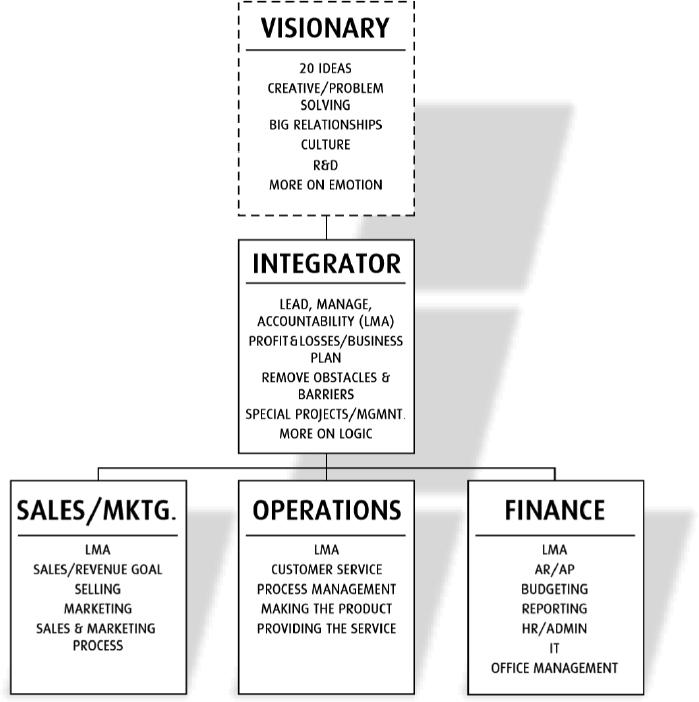
When you’re finished, the Accountability Chart should look like an organizational chart, with five bullets that illustrate the major roles of each function. Important note: The Accountability Chart will clarify function, role, and reporting structure, but it will not define communication structure. Your communication should flow freely across all lines and departments where necessary, creating an open and honest culture. With each position’s accountability clear and communication crossing all departments, you will avoid cross-departmental issues. The Accountability Chart should in no way create silos or divisions.
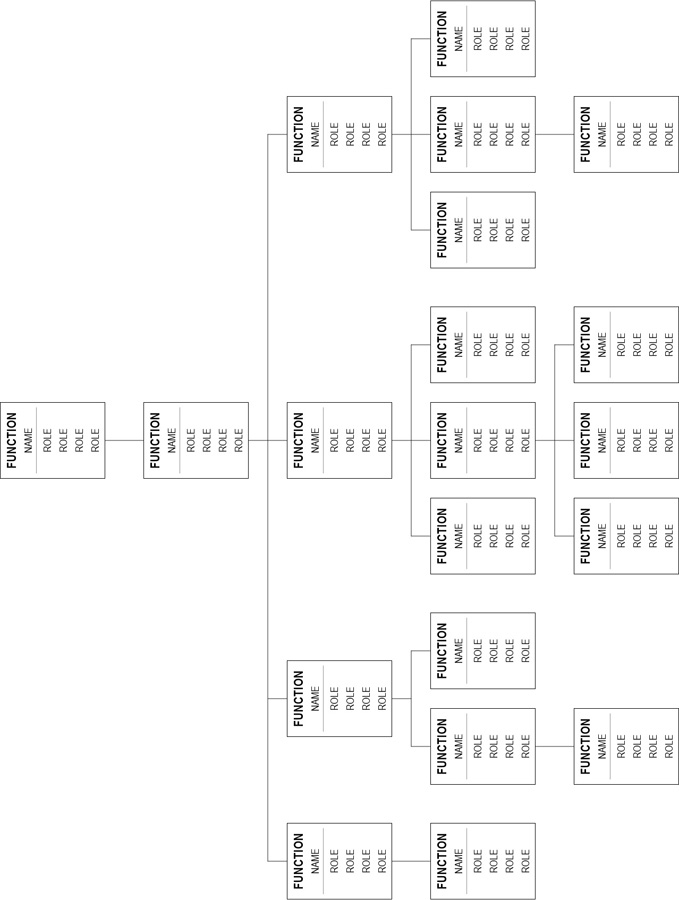
YOUR LEADERSHIP TEAM
With the completion of your Accountability Chart, the visionary, if you have one, the integrator, and the people heading up the major functions will become your leadership team. You now have representation and accountability for all the major functions of the business. Now that your leadership team is clearly in place, the next four chapters will address how you meet, prioritize, communicate, report, solve issues, and execute your vision.
GWC
Your completed Accountability Chart clarifies who is accountable for what. With this level of clarity, it’s time to put all the right people into the right seats. To do that you need only one filter: GWC.
GWC stands for get it, want it, and capacity to do it. GWC is a tool that stemmed from thousands of hours of working with leaders. The concept crystallized for me while sitting in a coffee shop with a client. We were discussing why one of his moves, that of elevating one of his key people to the role of integrator, hadn’t yet borne fruit. He had the right person, but the promotion hadn’t worked. At that moment, the answer to a question that had been bothering me clicked into place. After hundreds of sessions, I suddenly understood why filling seats hadn’t worked for some. I explained the concept of GWC to him. As a result of the clarity GWC gave him, he immediately realized he had made a wrong-seat mistake. The person who got the job had wanted it, but didn’t have the capacity to do it. That person was promptly removed from the role and put in a more suitable position, where he now excels.
The discovery came after observing many who’d been given seats but did not step up and fully assume their roles. These people were not fully performing because one of the three factors was absent. They didn’t get it, didn’t want it, or didn’t have the capacity to do the job.
To reach the next level, you need the people that report to you to be able to take the ball and run with it. When you as their leader or manager clearly articulate the seat (including roles, responsibilities, expectations, and measurables) and present that opportunity, you have created an opening. One of two things will happen as a result: Either they will step up and take charge, or they never will. If they don’t, it’s because one of G, W, or C is missing. In this scenario, you’ll be frustrated, they’ll be frustrated, you’ll never be able to delegate and elevate, and you’ll always be forced to do some or all of their work. Let’s break down these assets one at a time.
Get It
You’ve seen people who get it and people who don’t. “Get it” simply means that they truly understand their role, the culture, the systems, the pace, and how the job comes together. Not everyone gets it. The good news is that there are plenty who do.
Want It
This means they genuinely like the job. They understand the role, and they want to do it based on fair compensation and the responsibility. In many instances, a manager feels the need to motivate, overpay, or beg a person to want it, when the reality is they don’t. Sometimes their ego, your hopes, or their ignorance about what the job entails will lead them to think that they want it. But if they don’t, they’re never going to provide that spark, no matter how effective a manager you are. So stop beating your head against the wall. Find someone who does want it, and the difference will be immediately apparent.
Capacity to Do It
Capacity means having the time as well as the mental, physical, and emotional capacity to do a job well. Sometimes, a position might require a commitment of 55 hours a week where the person is only willing to commit 40. Sometimes the job requires a certain level of intellect, skill, knowledge, and emotional intelligence, and the person doesn’t have that capacity. This is the Peter Principle at its finest, where people are elevated to a level of incompetence.
A “no” on any of these three means it’s not the right seat for the person, it’s not their Unique Ability®. You must not fool yourself on this point. You can occasionally turn a “no” into a “yes” if you’re willing to invest the time and money it takes to elevate a person. However, in most cases, you won’t have the time to wait for them to adjust to the learning curve.
Be careful not to assume you already have people to fill the major functions. Just because they currently have the job doesn’t always mean that they get it, want it, and have the capacity. Using the filter of GWC will keep you honest with yourself.
When Ronnisch Construction Group, a general contractor with revenues of $44 million and 37 employees, started the process, Bernie Ronnisch, the owner and integrator, had a leadership team of four. As an unbiased party, I can tell when someone is not going to cut it on the leadership team very early on, usually well before the integrator sees it. In this case, two out of the four members were not going to make it—that’s 50 percent of the team! We struggled through the tasks of setting quarterly priorities, creating the Accountability Chart, and discovering core values, and then went through several quarters of poor completion on achieving those priorities. In a fit of frustration, I asked the two members directly how committed they were to this process on a scale of 1 to 10. They both gave a 4.
That was all Bernie had to hear to make some tough changes. Though both were very talented, he removed them from the leadership team. One he let go, and the other was moved to a superintendent role and shortly thereafter quit. Bernie replaced them with the right people in the right seats. Eighteen months later, the company grew 50 percent in that calendar year. Once a solid leadership team of five (Bernie added a major function) was firmly in place, they went to work on the rest of the company. Painfully they turned over 40 percent of their employees. As a result, they now have the right people in the right seats organization-wide. Four years after starting The EOS Process, their growth of 70 percent last year put them seventh on the Crain’s Detroit Business list of fastest-growing companies. They were also a finalist for the Ernst & Young Entrepreneur of the Year award.
I’ve been tracking a statistic over the last 11 years regarding my client leadership team changes in their first two years of implementing EOS. The data shows that 80 percent of the time, there’s a change in the leadership team as a result of this process. This means that most of the time, the leadership team that you start with is not the one you will end up with. Half the time, the change is removing someone from the team, and half the time, it’s adding someone to the team. The point is this: If you’re truly going to commit to building a great company, a strong leadership team, and getting the right people in the right seats, you must prepare for change on your leadership team. However, you may be one of the 20 percent in which there is no change.
Life is much easier for everyone when you have people around you who genuinely get it, want it, and have the capacity to do it.
With GWC now clear, incorporate it into your People Analyzer. When you’re evaluating your people, the rating on GWC should be a black-and-white “yes” or “no,” unlike the pluses and minuses for core values. You must get a “yes” on all three, or the person is in the wrong seat.
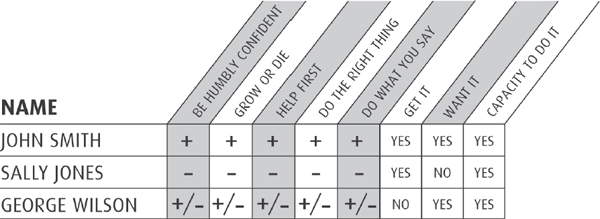
ONE NAME, TWO SEATS
You can have one name in two seats, just not two names in one seat. When an organization first starts out, the founding entrepreneur occupies every seat. He or she is the one name in all seats. He or she is the integrator, the head of sales and marketing, the head of operations, and the head of finance. As the organization grows, new people are brought in to fill the seats needed. For instance, once the entrepreneur reaches capacity, he or she then brings in someone to run operations and is able to let go of that major function.
If you’re at a point where you have people in more than one seat—for instance, your bookkeeper is also your shipping person and your customer service person—that is okay, as long they have enough time to do both jobs well. It’s a matter of the size of the organization. If they or you don’t have enough time to be in all seats, that will have to change. This leads us to the next point.
DELEGATE AND ELEVATE
As your company grows, you have to rise to your Unique Ability®, and the same goes for your leadership team. With your Accountability Chart in place, you can now determine when someone is working at full capacity. Each person only has 100 percent of his or her working time. This 100 percent represents the amount of time each person is willing to work and still maintain balance. For some people, it’s 40 hours per week, and for others, it’s 70 hours. Everyone is different.
When the amount of work requires more than 100 percent to do the job well, say 120 percent, something has to give. This person needs to delegate and elevate the extra 20 percent because he or she is holding the organization back and hitting the ceiling. In some cases, it’s time to move this person into one seat rather than the two he or she is occupying right now. If this person is in one seat, he or she needs to delegate more to other people, realize some efficiency, or eliminate some tasks altogether. At all times, you want to make sure that this person is drawing closer and closer to his or her Unique Ability®.
For example, assume you have a great operations and a great finance person in place, freeing you up from those major functions. Yet your workload is still requiring 120 percent of your time in order to lead and manage your leadership team as the integrator, manage the sales team, sell, and create marketing materials. It’s time to let go of something else. Assuming that leading and managing the leadership team and selling are your Unique Abilities®, you must delegate managing the sales team and creating marketing materials to free up the 20 percent. Delegate to the right person in the right seat and elevate yourself to your Unique Ability®.
When you delegate and elevate, it’s vital that you have the right person in the right seat. If you don’t, you’ll never feel completely comfortable letting go. You must also realize that you have no choice but to delegate. If you’re at 120 percent, you’re holding the organization back and probably starting to burn out. You no longer have the time to fully run the company and manage the sales team well—never mind those other jobs. If the only reason you’re not letting go is because of the person occupying the seat, it’s time to make that tough decision. You can’t keep doing this person’s work for him or her. You can’t keep taking on his or her “monkeys,” as Hal Burrows, William Oncken, Jr., and Kenneth Blanchard illustrated so well in their book, The One Minute Manager Meets the Monkey.
Envision all of your direct reports’ responsibilities, problems, and issues as monkeys. When your direct report walks into your office with a problem, he or she is trying to leave his or her monkey with you. At the end of the day, after multiple people have walked into your office with their problems and left them with you, you end up with 20 monkeys jumping around your office. If someone walks in with a monkey, he or she needs to walk out with it. If he or she can’t or won’t, you’ve hired the wrong person.
Tyler Smith of Niche Retail is a textbook example of someone who has been able to constantly delegate and elevate as his organization has grown and continuously broken through new ceilings. When Tyler and his partner, Brad Sorock, started their Internet retail company (with Tyler as integrator and Brad as visionary), Tyler handled all sales, operations, and finance, while Brad was in the lab researching and finding the next product idea and strategy. Tyler would get a ping on his cell phone indicating he had received an order, and he would go down to his basement and print the order, package it, and ship it out. He would then process the payment, order from his supplier, and pay the bills. This went on for the first year.
As the business grew, he reached full capacity. He couldn’t do all of his former jobs anymore. His first delegation and elevation was to his wife, Stacey, who helped him pack boxes. Soon, they reached capacity again. He hired someone to help him ship orders, and he let go of that function completely. He then moved to a 2,000-square-foot warehouse that could handle all of the inventory, which created the need for an operations manager. He then hired a bookkeeper and let go of that function. The growth continued.
Niche moved to a 10,000-square-foot warehouse. That created the need for a CFO and then a COO, as well as a head of site stores and marketing. Further growth required an 80,000-square-foot warehouse, and the story continues to this day. Tyler masterfully delegated and elevated each time he reached capacity, avoiding burnout. In addition, each member of the leadership team continues to delegate and elevate as the organization continues to grow. Here is Niche Retail’s evolving Accountability Chart:

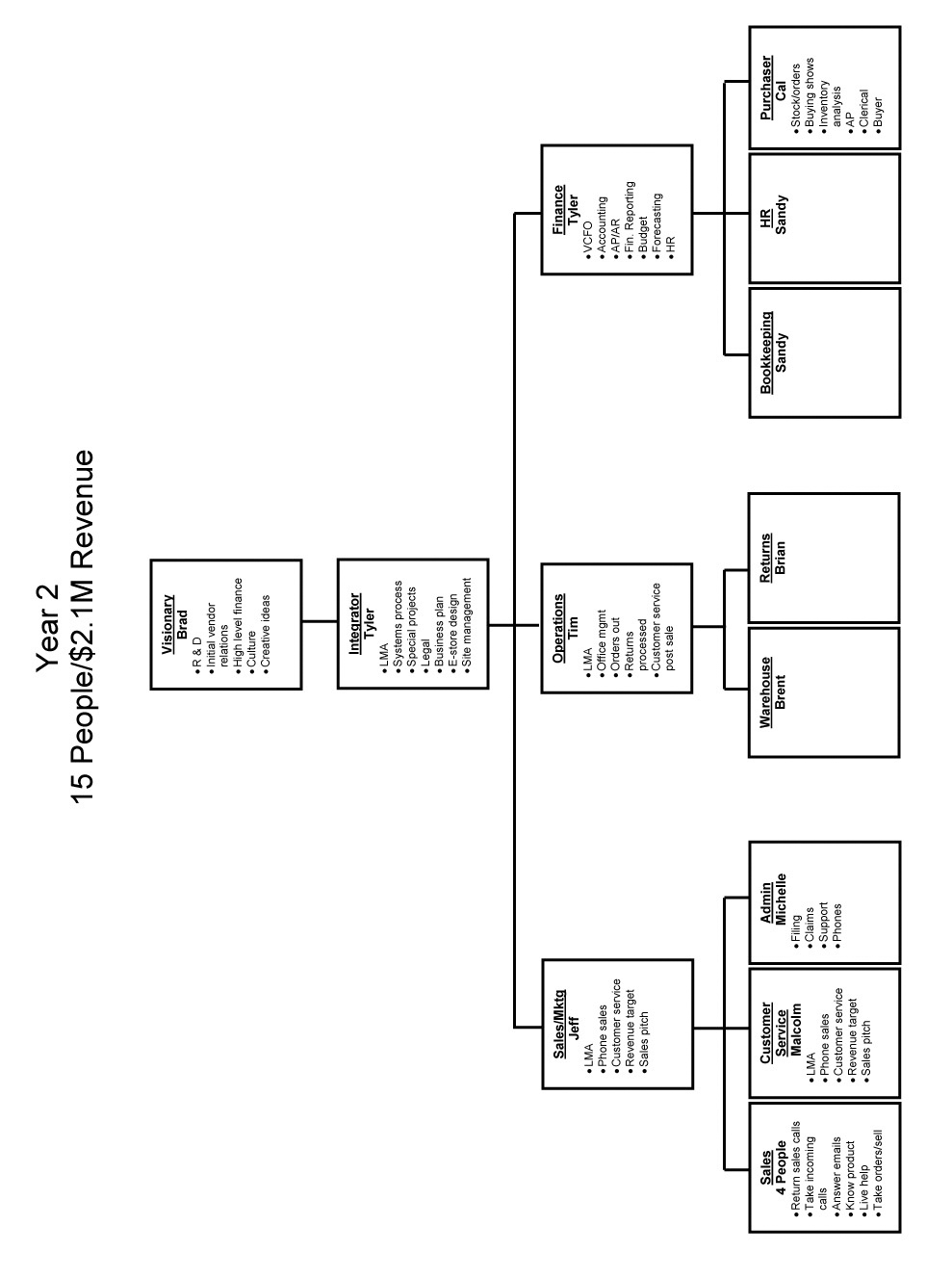
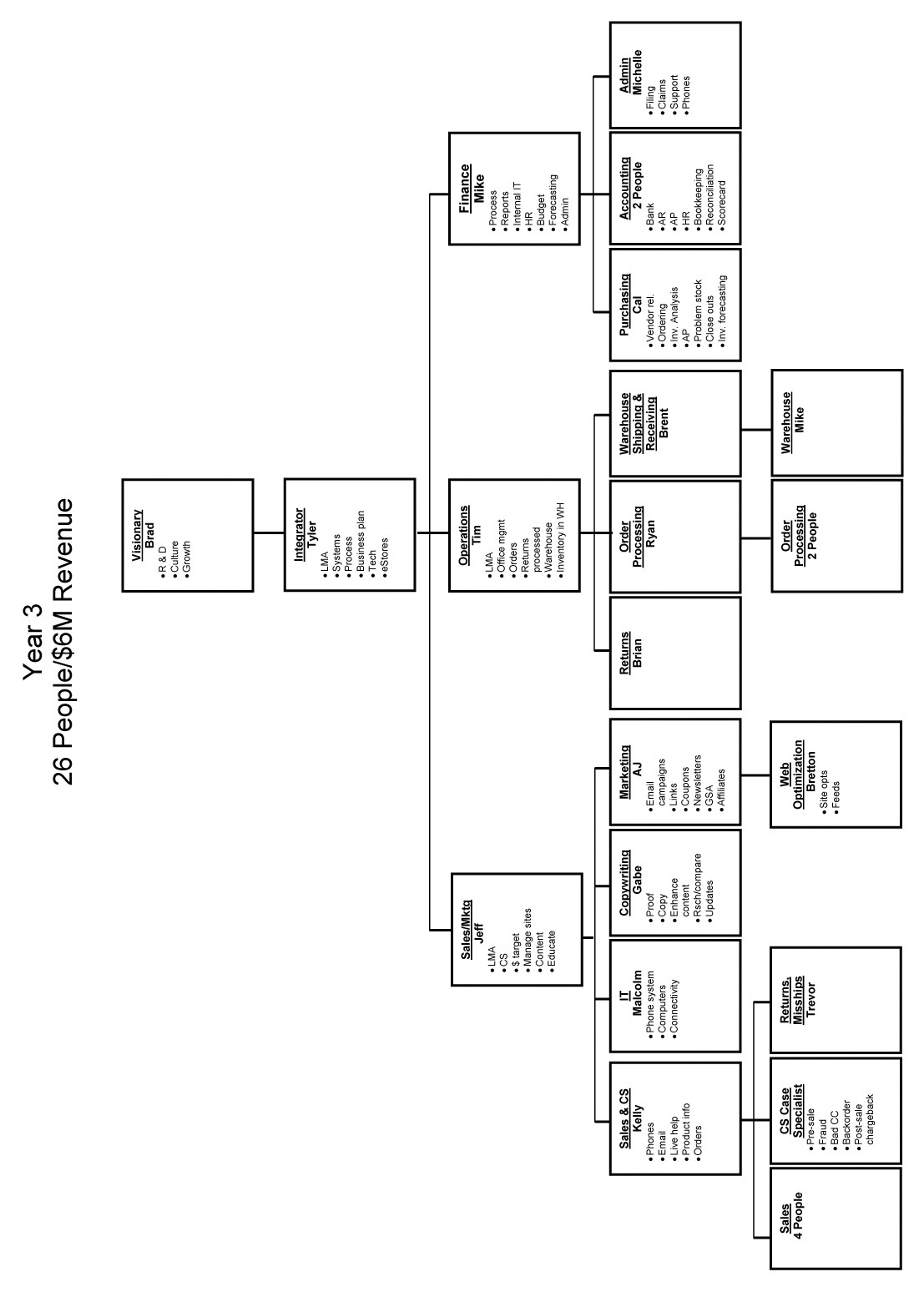

EVOLUTION
As your organization grows, your Accountability Chart will constantly evolve and change, as you can see in the example on the preceding pages featuring Niche Retail. This is a dynamic tool. Think back to what your structure looked like when you were half your size. Now imagine what it would look like at double the size. What are the differences? The point is that the Accountability Chart is an ever-evolving tool if you’re growing. At a growth rate of 20 percent, you will make a change to the Accountability Chart about every 90 days.
SCALABILITY
When you build out your Accountability Chart, you will notice that certain functions require multiple people doing the same job (e.g., salespeople, customer service representatives, accounting clerks). The Accountability Chart becomes scalable. Where multiple people have the same job, you simply put the number of people in that function rather than adding multiple new boxes.
For example, if you look at Niche Retail’s Year 5 Accountability Chart under the call center manager, you’ll see the customer service representative (CSR) function with eight people in it.
YOUR EXISTING ORGANIZATIONAL CHART
You may be wondering what to do with your existing organizational chart. Your newly created Accountability Chart should replace it and become the tool you use to illustrate the organizational structure. It clearly shows the reporting structure and the roles and responsibilities of each function. Keep it simple. The next step is to share it with everyone in your company. They’ll appreciate knowing where they fit and what they are accountable for.
From there, assuming they have your core values and GWC, let go of the vine and let them execute. You will experience the incredible results that come from harnessing all of their combined talents.
TERMINATIONS
A word of caution: Now that you’ve created clarity, you’ll clearly see the people that do not fit in the organization. Yet you shouldn’t run out and fire them all. That would make you vulnerable as an organization and leave some gaping holes.
Take a methodical approach to personnel changes, making sure that everyone on the leadership team is on the same page and then moving forward step by step. This doesn’t give you an out. It just means that you can’t put the company in a vulnerable position. You still have to make the change.
Once, my parents went out of town at a time when my two teenage brothers and I still lived at home. Upon their return, my dad realized we hadn’t watered my mom’s plant and it was quickly dying. We decided that overwatering it would do the trick, and of course it didn’t. Upon noticing the problem, my mom simply grabbed a pair of scissors and pruned a few dying limbs. The plant came back to life a short time later.
You must do a little pruning from time to time for the organization to flourish. Merely hoping that poorly fitting people will make it, sending them to a seminar, or giving them a pep talk is like overwatering the plant. It isn’t going to solve the problem. Once you do the necessary pruning, your organization will be revitalized.
36 HOURS OF PAIN
If people must go, and you’re procrastinating because the prospect of firing them seems painful, hopefully this will give you some motivation. During the evolution of Niche Retail illustrated on the previous pages, Tyler Smith kept someone around for a year too long because he was having a really hard time making the decision to let the person go. What made it equally tough was this person had been with them through the early years. The company outgrew him, though. He was aware of this, and over time, his attitude had soured. The leadership team finally pulled out the People Analyzer and the results showed there was simply no other option. The person was no longer right for the organization. As a result, after much anguish and soul-searching Tyler finally made the tough decision to let him go. A couple of days later, Tyler called me and shared a term that is now an EOS staple: 36 hours of pain.
The hours leading up to and including the termination were painful, but after that point, he realized it was one of the best decisions he had made for the greater good of the company. He couldn’t understand why he hadn’t done it sooner. The work environment was so much better and less tense for everyone. He was relieved.
Other employees thanked him for making the tough decision. He experienced all that pain for a year, when in hindsight he could have experienced only 36 hours of pain, probably for both parties. Incidentally, the terminated gentleman is now doing well and pursuing his passion. The decision was best for all.
If the People Analyzer shows you that someone is the wrong person for your organization, make the decision. And yes, there will be some pain, but only for about 36 hours.
Keep two important points in mind:
1. Be careful what you wish for because you’ll get it. If you want to grow, you have to understand that not everyone is going to be able to keep up and remain in the same seat forever.
2. Keeping people around just because you like them is destructive. You’re doing a disservice to the company, to everyone in it, and to the person. People must add value. I realize this may sound cold, but to the degree people are in the right seats, everyone is happier, especially them.
THE THREE QUESTIONS TO ASK
When a client completes its Accountability Chart, we ask three questions to confirm that it is at 100 percent. Please ask these three questions with your leadership team:
1. Is this the right structure to get us to the next level?
2. Are all of the right people in the right seats?
3. Does everyone have enough time to do the job well?
A “yes” on all three confirms that you’re at 100 percent in this essential component.
We now know what great leaders mean when they attribute their success to surrounding themselves with good people. It’s putting the right people (core values) in the right seats (GWC and Unique Ability®).
With your vision clear and shared by all, and with the right people in the right seats, the next step is measuring your progress and having an absolute pulse on your business. That requires the use of data.
